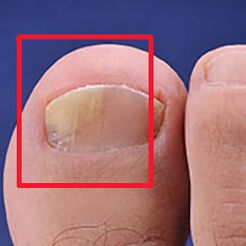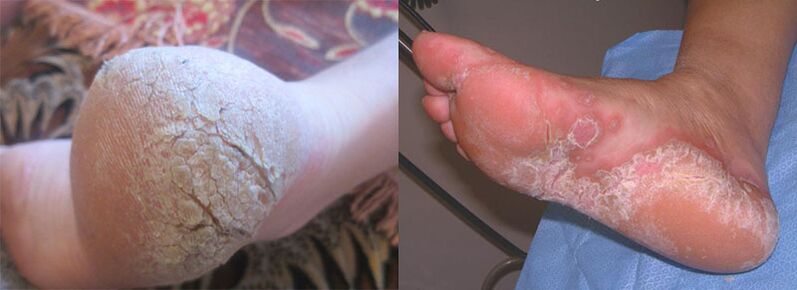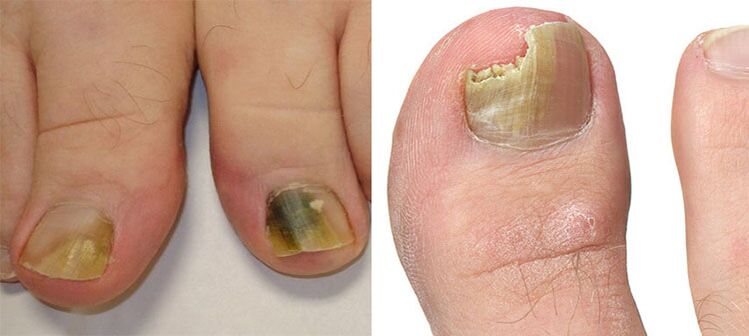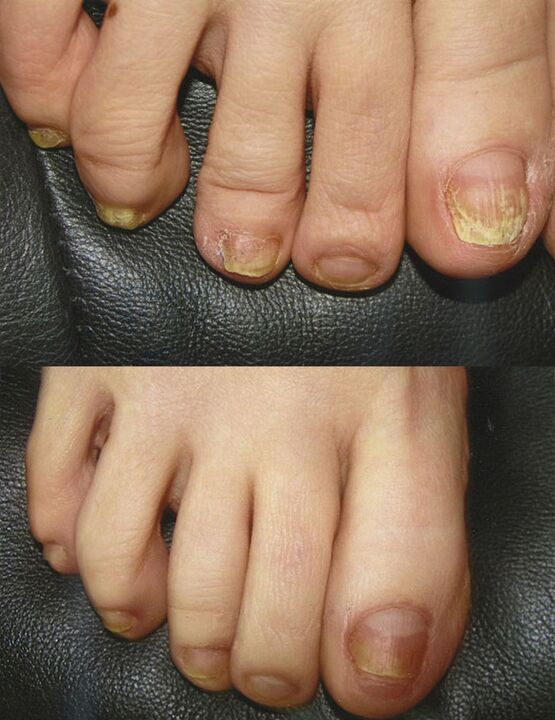The fungus of the legs, additionally called mycosis, is a widespread type of infectious disease. The pathological condition of the legs is not always associated with a mismatch with hygiene: a fungal infection can be easily taken in public places. It can touch the heels, nails, legs, toes, skin. At the same time, one is characterized by sensations of pain, discomfort, disgusting odor.

Powerful mushrooms can only be infected by a person, in turn, becoming a source of infection. The closest environment of the patient immediately falls into the risk group.
The active spread of fungi is facilitated by a neutral or weak alkaline environment. For example, with profuse sweating, the chance is the chance to "spread" mushrooms on closed skin of your feet. The fungus is not afraid of low temperatures: it is quite stable. After freezing, the ability to remain the pathogen is not lost. The effect of high temperature (above 70 degrees) destroys the fungi within one hour. In boiling water, the fungus "reaches the end" in three minutes. This distinctive feature can be used by disinfection of personal hygiene, clothing, underwear in which they are associated with fungal colonies. Personal items of the household are subject to boiling and ironing with iron. The shoes are cleaned with special solutions, such as one percent of formalin. The fungus will not live 20 minutes after processing.
Every tenth resident of the earth had to face a sponge. Often, men are the carrier and distributor of a fungal infection. They wear closed shoes for a long time. Women from this disease suffer less.
The causes of a fungal infection of the feet
As mentioned above, fungi "love" the humid environment. They quickly spread in a favorable environment for them:
- in wet shoes;
- Sauna;
- pool;
- gym;
- shower;
- In a manicure, pedicure salons through tools and accessories.
In those places where humidity is always present. The dried state of things and objects will only temporarily delay the reproduction of fungi. It is worth entering the environment that is known to life, as the growth process will resume.
Mycosis is more common than adults, pathology is practically not observed among children. With the increase in the number of years, the pH of the skin changes, the structure of its layer of horn, the immunity weakens and the body is subjected to many diseases.
The appearance of the sponge also contributes to:
- Improper, improper leg care;
- Wearing shoes with "strange leg" of bad quality material;
- endocrine diseases;
- ohthly pathologies;
- gastrointestinal diseases;
- impaired blood circulation in the lower limbs;
- Stop deformation;
- stressful situations;
- bad habits;
- multiple antibiotic therapy courses;
- Anemia.

Not all patients, noticing the pathological condition of the feet, feeling the unpleasant odor, hurry to the doctor. The process of reproduction of mushrooms is neglected, respectively, it is worse and more difficult to treat, requires a long time patient. It must be remembered that the fungal colonies that infect the human body are actively poisoned with toxins. The situation is worsened by the presence of open wounds, cuts, ulcers, etc.
Locations for localization and symptoms of a fungal lesion
The appearance of the fungus of the legs depends on the infection that affects the skin:
- dermatitis;
- candidiasis;
- Mycosis.
The location of the fungi also influences the process of developing the disease, namely:
The greater part of the suffering, one is brought to a person "five" fungal lesions. The legs and heels are covered with rough areas of the skin, scars, cracks. The infection is "passing": from one foot to another. At the site of significant redness of the foot begins peeling, wounds appear with a larger formation of a thickened bark. The patient experiences painful itching, it hurts to walk, the leg swells to the ankle. Emergency treatment for medical help is required as the advanced form of the disease is fraught with decay of infected skin.

The fungus between the toes exposes the skin, the fingers of the nail with the formation of deep wounds. Small wounds appear, the upper layer of the epidermis occurs. The space between the fingers itching strongly, "burns", emits bad odors. In the case of untimely contact with doctors, serious dermatological diseases can occur, it is difficult to treat in the form:
- psoriasis;
- eczema;
- Dermatitis.
The nails affected by a fungal infection is completely destroyed. The onset of the pathological process is characterized by the formation of spots under the nails of cyanotic, white, yellow. Over time, spots increase in size, capturing the entire nails. There is a thickening, deformity and destruction of the nail. The newborn nail is also subjected to fungal damage. Only a long course of treatment will contribute to the restoration of a healthy nail.
The symptomatic picture of fungal damage to the legs is always clearly pronounced in the form of certain places. Therefore, the pathology is easily determined at an early stage.
Folk remedies and methods against fungi
As the treatment of leg fungus takes a long time, the recovery processes can speed up the recovery process used in conjunction with medication treatment.
You can use any recipe found on the Internet, but you should consult a doctor before. Below are popular and widely used in practical recipes for the preparation of disinfectants used at home:
- Antifungal soda solution. Take two liters of boiled water (hot), 150 mg of sea salt, 100 g of baking soda. The solution is prepared from all components well mixed. The legs in such a solution should be kept for half an hour. After making sure that the steam process has acted, you can remove the rough skin, cut your nails. Then lower your feet again in the bath, keeping them there for a quarter of an hour.
- Iodine bathroom. Hot water (boiled) is also prepared, iodine solution when calculating 25 g per liter of water. The iodine is stirred in water, the legs are disinfected for 10 minutes, after which they are dried. You have to wear socks.
- Garlic mask with iodine solution. Hot boiled water, iodine, garlic cloves are taken again. First, the garlic is pressed through a special device, the resulting carton is applied to the area infected with a sponge for 10 minutes, then the legs should be washed with a warm iodine solution, drying and socks.
- Celendine chamomile solution. Take plants in 25 and 75 g. Accordingly, cook for a few 5 minutes. Strain the liquid. In this solution, bend your legs for 15 minutes. After drying them and putting socks. This healing broth not only kills the sponge, but also serves to rejuvenate the skin of the feet.

I have to say that effective fungus products are cheap medicines located in the house or sold in pharmacies. This greatly facilitates the task of prolonged use of the course. Excellent remedies include:
- Parkargana. It contributes to the rapid elimination of mycosis. It is used in the form of baths, compresses and applications in the affected areas.
- Propolis tincture. With its help, the development of the infectious process is blocked. It is used as applications and baths of five liters of water 50 ml of tincture. Keep your feet in the solution for at least ten minutes.
- Oils, propolis ointments. They do well with severe forms of fungal pathology. The oil is sold in pharmacies and can also be cooked at home, mixing in equal parts with any antiseptic oily agent. It is better to use it at night.
- SBoric acid. This will quickly help to restore if it lubricates the space affected by the fungus between the toes.
- Alcohol is ammonia. Used for all night compresses.
In the kitchen in every house you can find funds for unconventional medicine successfully used to combat fungi. To do this, use:
- Vinegar (dining room, apple, wine). The production of ointments, the preparation of baths, compresses are found on their basis. Vinegar blocks the developing process of fungal damage.
- Nutritional soda. His help prepare pastas, baths, powders.
- Garlic. This is a powerful antibacterial agent that helps to cope with the fungi. There are many recipes that take into account different characteristics of the disease and the human body.
- Coffee. It is used for baths in the form of a strong solution. Legs rise in it for 10-15 minutes
- Onions. Gruel prepared by it should be applied to infected areas. You can use Vaseline with open wounds, mixing with onions in the same proportions.
- Chicken egg. For the treatment of the fungus, the egg is immersed in vinegar for 24 hours. Remove the movie in the morning, 10 g of cream oil is added to the rest of the liquid, everything is mixed. It turns out to be a "magic" ointment to destroy the sponge.
- Tea sponge. It handles the growth of pathogenic bacteria perfectly. It can be used as friction and compresses.
Prevention
At the first signs of a fungal lesion, you should consult a doctor to start treatment.
To avoid the disease, you need proper hygiene care for the feet, providing cleanliness and healthy surface of the skin. You should wear clean and high quality socks and shoes. Do not get involved in a visit to public places where you can "take" a fungal disease. If you are there, you need to follow the rules of personal hygiene using only your things and accessories.
Experts also recommend regular antioxidant intake:
- ginseng;
- Sea oil from hobs;
- Essential;
- Vitamin E and other vitamin complexes.
You need to protect your feet from injury to take careful care with high sweating. The shoes inside should be treated with special tools that prevent humidity.
Guest does not need to wear slippers and other homemade shoes at home, it is better to take your own. You should also beware of trying shoes, sandals and other barefoot shoes in stores. You should always wear clean socks with you for these purposes.
After all water procedures, you should wipe your feet dry, paying attention to the spaces between your fingers.
If a suspicion of a fungus infection occurs, you should use the local antifungal agent and start treating yourself after a doctor's visit.

















